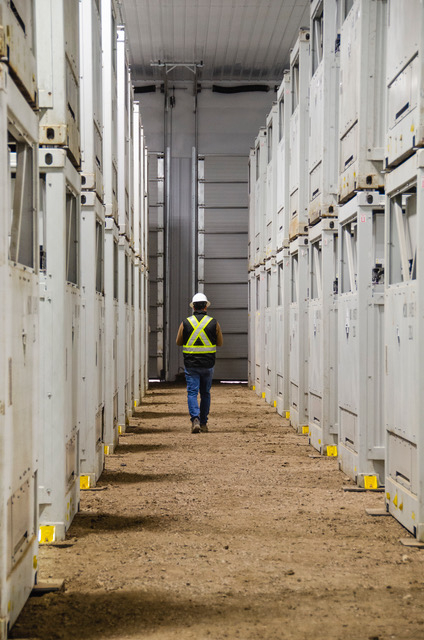Support strong Canadian climate journalism for 2025
Renewable energy is a tremendous economic opportunity for any community with the foresight to embrace it. The capital cost of building wind and solar infrastructure continues to fall as demand grows exponentially around the world. At the same time, performance improvements will continue to increase the efficiency of generating electricity from renewable energy assets.
The world has been dominated by electricity generated from fossil fuels for over a century, but renewable energy is emerging as a daunting competitor. According to the International Energy Agency, “Global renewable capacity additions are set to soar by 107 gigawatts (GW), the largest absolute increase ever, to more than 440 GW in 2023.”
China alone is expected to increase wind and solar capacity to 1,200 GW by 2025 and the United States, European Union and India also have aggressive goals for renewable energy.
In Canada, when the much-promised carbon capture and storage (CCS) infrastructure is added to fossil-fuel-based power plants, both capital and operating costs will increase for these energy systems. As a result, wind and solar energy will have an even greater competitive advantage.
CCS is the expensive solution that only solves about 20 per cent of the greenhouse gas (GHG) emissions problem while adding a great deal of complexity to the system. Renewable energy is far less complex, which translates into greater long-term reliability and lower maintenance costs.
The intermittent nature of the sun and wind is a challenge being solved in many countries formerly reliant on fossil-generated electricity. Sharing electricity between neighbouring electrical grids is one way to tackle the problem. Another way to bridge gaps in renewable supply is with energy storage solutions, also known as grid batteries. This is relatively new technology, but costs are rapidly declining while performance is steadily improving.
Premier Danielle Smith is stating that Alberta needs until 2050 to equip its fleet of natural gas generating stations with CCS. By that distant year, renewable energy with long-duration grid batteries will be far less expensive to operate, giving economies that have adopted emerging renewable technologies a compelling advantage with a clean and low-cost energy supply.
In the southeast corner of Alberta, about 100 kilometres from the United States border, a small solar project was recently completed near Chappice Lake. The 14-megawatt (MW) solar farm also included 8.9 MW hours (MWh) of energy storage, which provides additional generating capacity when the sun goes down.

The project is a partnership between Elemental Energy based in Vancouver and the Cold Lake First Nations in northern Alberta. Elemental’s director of project development, Dan Eaton, explained that his company has a history of developing projects with First Nations and was discussing potential opportunities with Cold Lake leadership for several years prior to the Chappice Lake project.
By incorporating energy storage, Elemental was able to build extra solar capacity on the site. The grid connection limit was approximately 14 MW, but Elemental installed 22 MW of solar-generating capacity to maximize the use of the leased land. Excess energy is stored in the grid battery. This stored energy can be sold at times when electricity generation is below the 14-MW limit. The grid battery also permits storing electricity when market prices are low and selling to the grid when prices are higher.
According to Eaton, the vanadium redox flow energy storage technology used in the Chappice Lake project was developed in Canada by Avalon Battery before the company merged with a U.K. firm to form Invinity Energy Systems. Avalon’s flow battery technology has significant advantages for grid applications over more commonly used lithium-ion grid batteries.
Although more expensive, flow batteries have an unlimited cycle life allowing them to be charged and discharged every day over the lifespan of the power plant. Lithium-ion battery performance degrades as the cycle count increases and storage capacity will start to decline after a number of years.
Flow batteries also contain no flammable materials and can provide longer battery life simply by increasing the size of the tanks containing the liquefied storage medium.
When asked what advantages Alberta has for renewable energy developers, Eaton cited the existing workforce with energy experience and a strong base of renewable companies that can support the design, approval and construction of new projects.
Furthermore, Alberta’s deregulated market allows for partnerships with existing utility companies and the use of power purchase agreements directly with businesses like Amazon, which is a unique opportunity to sell power to companies looking to green their energy consumption.
Despite the recently announced moratorium on renewable energy projects in Alberta, Eaton was still optimistic about the future of renewables.
“Alberta is Canada’s energy heartland and energy development is at the core of the economy of Alberta. So you have a lot of knowledge and a lot of skilled people there. You have a lot of resources that have been developed in the past and we see renewable energy as rather complementary to Alberta’s existing energy assets.”
Southern Alberta has an exceptional amount of sun, wind and wide open spaces. The land is ideal for connecting large amounts of renewable capacity to the grid while consuming negligible amounts of agricultural land. But solar energy can also be built in smaller sizes and widely distributed to areas closer to where the energy is being consumed.
From residential solar systems to megawatt installations on shopping malls and parking garages, any individual, community or business can generate their own clean energy. This kind of distributed electricity system will reduce Alberta’s dependence on its natural gas generating capacity and render large investment in these assets economically unfeasible.
Who wouldn’t want to build a local and affordable power plant that eliminates monthly charges for fuel, distribution, transmission and network management costs? The energy transition won’t eliminate electricity generation from large utilities, but it will transfer a significant amount of revenue and profit from companies reliant on fossil fuels to individuals and growing Canadian businesses.
The majority of Canadians don’t share the Alberta government’s “can’t do” attitude regarding clean electricity regulations (CER). In fact, Alberta was already well on its way to eliminating coal-generated electricity and doubling renewable capacity before the CER was released.
Unfortunately, Alberta politicians are pivoting away from these forward-looking trends and are now working to curtail a booming renewable energy industry while delaying the rollout of CCS technology to 2050. Smith also recently launched a nationwide advertising campaign to discredit renewable energy. Fortunately, pulling the wool over the eyes of Canadians is as unsustainable as the polluting energy system Alberta’s conservative government is fighting to preserve.
Rob Miller is a retired systems engineer, formerly with General Dynamics Canada, who now volunteers with the Calgary Climate Hub and writes on behalf of Eco-Elders for Climate Action.






Comments
Miller: "CCS is the expensive solution that only solves about 20 per cent of the greenhouse gas (GHG) emissions problem while adding a great deal of complexity to the system."
True of CCS applied to concentrated waste streams in fossil-fuel production.
Presumably, CCS applied to fossil-fuel power generation approaches 100%.
That said, the Alberta Electric System Operator (AESO) remains sceptical about carbon capture even in the power sector:
"… Guilbeault also said all new gas-fired electricity generation after 2035 would require carbon capture technologies with a few exceptions. During his press conference Thursday, AESO president and CEO Mike Law expressed scepticism around the viability of such technology in the short-term.
"'Uncertainty with developing low-carbon technologies — whether carbon capture, hydrogen, small modular reactors — means Alberta is at a greater reliability and cost risk if cost and performance do not materialize as currently anticipated.'
"Premier Smith says Alberta preparing Sovereignty Act motion over federal emissions plans" (CBC, Sep 28, 2023)
Miller: "In Canada, when the much-promised carbon capture and storage (CCS) infrastructure is added to fossil-fuel-based power plants, both capital and operating costs will increase for these energy systems. As a result, wind and solar energy will have an even greater competitive advantage."
Not if taxpayers are forced to pick up the tab. If the oilsands sector can dump most of its CCS costs on taxpayers, why would the power sector not insist on equal treatment?
Miller: "This kind of distributed electricity system will reduce Alberta’s dependence on its natural gas generating capacity and render large investment in these assets economically unfeasible. … Who wouldn’t want to build a local and affordable power plant that eliminates monthly charges for fuel, distribution, transmission and network management costs?"
A) The natural gas industry, fossil-fuel players in the power sector, and O&G lobbyist/Premier Danielle Smith.
Alberta's UCP government will fight tooth and nail against renewable energy, spreading misinformation and fear:
"Tell the Feds."
"No one wants blackouts.
"Ottawa’s proposed electricity regulations will make electricity unreliable & unaffordable.
"No one wants their power bill to quadruple.
"The things Canadians count on won’t work when needed.
"Canada can’t afford a hasty transition."
https://tellthefeds.ca/
Excellent article.
It should also be noted that Alberta's private electricity utilities have recently quadrupled their rates. Why? Presumably because they can when there is little competition from cheaper and far more benign renewables. The timing seems remarkably coincidental with the UCP's ill-considered moratorium on renewables.
I think they are shooting themselves in the foot. What mall, farm, commercial warehouse, office tower or home owner will tolerate power bills suddenly jacked up by 4-5X over time? Large, flat roofs are perfect for solar PV panels, especially in sunny Alberta, and large commercial basements and above ground parking lots are perfect sites for battery banks. What's stopping them from developing their own on-site power, as long as they are up to modern electrical codes and they don't try to sell power to the grid? What's stopping neighbourhoods and entire towns from starting their own private power utility designed solely for their own consumption? 1,000 roofs in a town makes for a lot of solar arrays, and the Smith government cannot touch them as long as they are independent from the provincial grid, but I'm sure they'll try if individual energy self sufficiency really catches on because it is a fraction of the cost of the provincial grid. Extend the moratorium or put up too many hurdles to renewables and non-grid power is bound to be developed for own-use purposes. If done at a large enough scale, Smith may even be dumb enough to consider forming a Solar Police force to rip panels off private roofs and wind turbines out of farmer's private fields. The backlash would make international news, I'm sure.
Centralized power agencies, both public and private, need to really look at the potential for decentralized power generation by independent owners. They'll probably conclude it's better to go with the flow and accommodate it than to fight it.